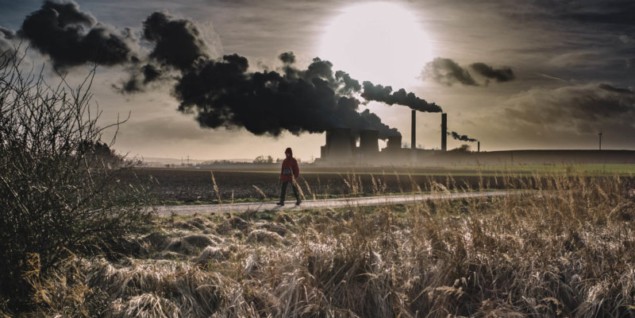Tripled climate cuts needed to fulfil pledge
30 Nov 2018
The world needs to cut greenhouse gases three times faster. Image by Thomas Hafeneth on Unsplash
The world is not yet living up to its undertaking to tackle global warming, and it will have to make tripled climate cuts − at least − if it is to do so, a report says.
The emissions gap − the difference between the global emissions of greenhouse gases scientists expect in 2030 and the level they need to be at to honour the world’s promises to cut them − is the largest ever.
The 2018 Emissions Gap Report is published by the UN Environment Programme (UNEP). While it is still possible to keep global warming below 2 °C, its authors say, the world’s current pace of action to cut emissions must triple for that to happen.
In 2015 almost 200 governments adopted the target of keeping global warming to no more than 2 °C above pre-industrial levels, and to try for a lower level, 1.5 °C. Their decision is set out in the Paris Agreement.
Inadequate targets
But the Gap Report spells out in detail a criticism scientists have been making since soon after the Agreement was reached, saying the current pace of countries’ plans for reducing emissions − which they decide for themselves − is not enough to meet the Paris targets.
As well as allowing signatories the freedom to cut emissions as savagely or as modestly as they wish, the Agreement is also condemned by those who believe its targets are themselves so unrealistic that they fail to measure up to the scale and urgency of the climate crisis.
The combination of increasing greenhouse gas emissions and increasingly inadequate action to slow them means that the emissions gap is bigger than it has ever been.
Meeting the 2 °C target will require climate action efforts to triple, the Gap Report says. But to meet the 1.5 °C limit, which many governments and scientists are urging, needs nations not just to triple their efforts, but to increase them five-fold.
The science is clear … governments need to move faster and with greater urgency. We’re feeding this fire while the means to extinguish it are within reachJoyce Msuya, UN Environment
Current action to limit emissions suggests that global warming will reach about 3°C above pre-industrial levels by the end of the century, and will continue to rise after that. If the gap is not closed by 2030, the report’s authors say, it is highly unlikely that the 2 °C target can be reached.
In 2017 global emissions rose again, after a three-year decrease, as countries’ efforts to combat climate change fell short of what was necessary for global emissions to peak. That year global emissions reached reached 53.5 gigatonnes of carbon dioxide equivalent (GtCO2e), the highest levels yet recorded. Just 57 countries, representing 60% of global emissions, were on track to peak emissions by 2030.
(A gigatonne is a thousand million tonnes. “GtCO2e” is an abbreviation for “gigatonnes of equivalent carbon dioxide” − emissions of various GHGs put on a common footing to express them in terms of the amount of CO2 that would have the same global warming effect.)
The Gap Report has been released just before this year’s UN global climate summit, the 24th Conference of the Parties (COP24) to the UN Framework Convention on Climate Change (UNFCCC) in the Polish city of Katowice.
Critical decade ahead
Two of the contributors are researchers from IIASA, based in Laxenburg, Austria: Joeri Rogelj and Daniel Huppmann.
“This year’s report shows with renewed urgency that emissions reductions in the next decade are critical, and that there are readily available options to achieve this,” said Rogelj.
New, more conservative assumptions about the potential contribution of negative emissions technologies (geoengineering) in the future mean that even bigger emissions cuts will be needed.He is a lead author of the chapter that updated the assessment of the emissions gap, which found that little or no progress had been made in the past year on new policies or more ambitious pledges.
Huppmann led the year-long effort to compile a large database of emissions scenarios through the IIASA Scenario Explorer. The 2018 Emissions Gap Report draws from this database, first published in Nature Climate Change.
Closing the gap
The report outlines a roadmap which could still meet the Paris Agreement targets and close the emissions gap by 2030. It includes possible contributions by government fiscal policy, the pace of innovation, and a review of climate action by groups other than governments.
If they make commitments to the strongest climate action globally, the authors say, emissions could be cut by 19 GtCO2e, enough to close the 2 °C gap.
Governments could subsidize low-emission alternatives and impose higher taxes on fossil fuels. If a carbon price of US$70 a tonne were adopted, emissions could be cut by 40% in some countries.
Removing fossil-fuel subsidies would cut global emissions by 10% by 2030, compared with a situation where no climate policies were imposed.
“If the IPCC report represented a global fire alarm, this report is the arson investigation,” said UN Environment’s deputy executive director, Joyce Msuya. “The science is clear; for all the ambitious climate action we’ve seen, governments need to move faster and with greater urgency. We’re feeding this fire while the means to extinguish it are within reach.”
This article first appeared at Climate News Network
Alex Kirby is a former BBC journalist and environment correspondent. He now works with universities, charities and international agencies to improve their media skills, and with journalists in the developing world keen to specialize in environmental reporting
15/12/2018 fro physicsworld.com

Δεν υπάρχουν σχόλια:
Δημοσίευση σχολίου